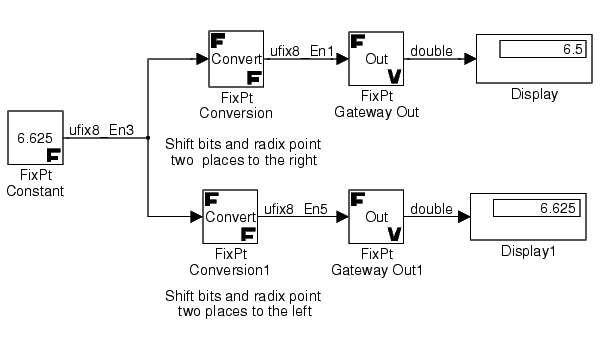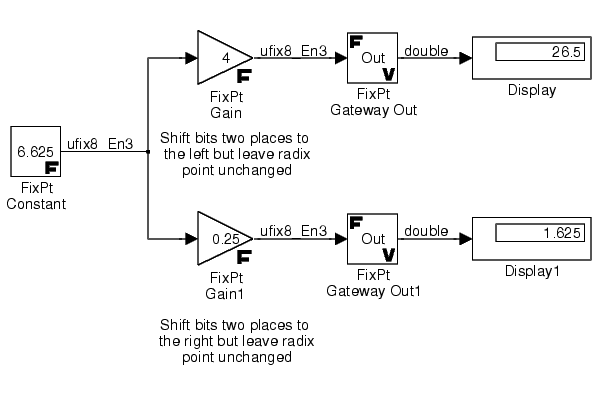

| Fixed-Point Blockset |   |
Shifts
Nearly all microprocessors and digital signal processors support well-defined bit-shift (or simply shift) operations for integers. For example, consider the 8-bit unsigned integer 00110101. The results of a 2-bit shift to the left and a 2-bit shift to the right are shown below.
| Shift Operation |
Binary Value |
Decimal Value |
| No shift (original number) |
00110101 |
53 |
| Shift left by 2 bits |
11010100 |
212 |
| Shift right by 2 bits |
00001101 |
13 |
You can perform a shift with the Fixed-Point Blockset using either the FixPt Conversion block or the FixPt Gain block. The FixPt Conversion block shifts both the bits and radix point while the FixPt Gain block shifts the bits but not the radix point. These two modes of shifting as well as shifting to the right are discussed below.
| Note Performing a "plain" or "raw" machine-level shift such as those given in the example above with the Fixed-Point Blockset is complicated by the available scaling options. Therefore, a single "FixPt Shift" block is not provided. For more information about scaling, refer to Scaling. |
Shifting to the Right
Shifts to the right can be classified as a logical shift right or an arithmetic shift right. For a logical shift right, a 0 is incorporated into the most significant bit for each bit shift. For an arithmetic shift right, the most significant bit is recycled for each bit shift. With the Fixed-Point Blockset, shifting to the right follows these rules:
Shifting Bits and the Radix Point
With the FixPt Conversion block, you can perform a shift operation on the input by specifying the appropriate radix point-only scaling for the output. This block shifts both the bits and the radix point.
In most cases, you will perform a "plain" or "raw" shift. To perform such a shift using the FixPt Conversion block, you must configure the block's dialog box this way:
Floor. Therefore, bits simply fall off the left or fall off the right when a shift occurs.For example, suppose you start with the fixed-point number 00110.101 (a decimal value of 6.625), which is characterized by the blockset as an 8-bit unsigned, generalized fixed-point number with radix point-only scaling of 2-3. To shift the bits and radix point two places to the right, the input scaling of 2-3 is multiplied by 22, which yields a scaling of 2-1. To shift the bits and radix point two places to the left, the input scaling of 2-3 is multiplied by 2-2, which yields as scaling of 2-5. This situation is shown below
| Shift Operation |
Scaling |
Binary Value |
Decimal Value |
| No shift (original number) |
2-3 |
00110.101 |
6.625 |
| Shift right by 2 bits |
2-1 |
0000110.1 |
6.5 |
| Shift left by 2 bits |
2-5 |
110.10100 |
6.625 |
The figure below shows the fixed-point model used to generate the above data.

Refer to Chapter 9, Block Reference for more information about the FixPt Conversion block.
Shifting Bits but Not the Radix Point
With the FixPt Gain block, you can perform a shift operation on the input by specifying the gain as a power of two. This block shifts only the bits and not the radix point.
In most cases, you will perform a plain or raw shift. To perform such a shift using the FixPt Gain block, you must configure the block's dialog box this way:
Floor. Therefore, bits simply fall off the left or fall off the right when a shift occurs.For example, suppose you start with the same fixed-point number, 00110.101, defined above. To shift the bits two places to the left, a gain of 4 is specified, and to shift the bits two places to the right, a gain of 0.25 is specified. This situation is shown below
| Shift Operation |
Gain Value |
Binary Value |
Decimal Value |
| N/A (original number) |
2-3 |
00110.101 |
6.625 |
| Shift left by 2 bits |
4 |
11010.100 |
26.5 |
| Shift right by 2 bits |
0.25 |
00001.101 |
1.625 |
The figure below shows the fixed-point model used to generate the above data.

Refer to Chapter 9, Block Reference for more information about the FixPt Gain block.
 | Division | Example: Conversions and Arithmetic Operations |  |